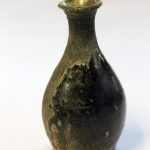An ailment that we can aptly characterize as hot-and-long disorder is epidemic in the world of pottery, and pottery aficionados need to be alert to the symptoms. Potters and galleries have propagated the fiction that higher temperatures and longer firing times inherently yield better pottery. The sales pitch typically goes something like this: “Well-fired” pottery is a higher grade of work. It results from prolonged, high-temperature firing. And it warrants premium prices.
Numerous pottery lovers have succumbed to hot-and-long disease have become infected with an unquestioning belief in the supposed virtue of “well-fired” work. That presents potters with a powerful temptation to exaggerate. Ask a potter, for example, about how hot and how long he or she fires pottery. If the truth is somewhere around five days at a maximum temperature of 1,200° centigrade, the potter might well give in to temptation and reply “seven days at a max of 1,300°.”
The culinary metaphor is a useful preventive for hot-and-long disorder. No one thinks that all dishes turn out better, the longer and hotter they are baked. Just imagine how your carefully prepared apple pie would look after two or—even better?—three hours in the oven at 250° centigrade or—even better?—300°. So just remember that each dish has an optimal cooking time and temperature. And bear in mind that each kind of pottery does, too.






